Emerging Pattern of Wind Change over the Eurasian Marginal Seas Revealed by Three Decades of Satellite Ocean-Surface Wind Observations
Abstract
1. Introduction
2. Materials and Methods
2.1. Data
2.2. Buoy-Based Validation over the Global Ocean
2.3. OAFlux-HR Wind Comparison with Three Buoys in the Study Domain
3. Results
3.1. Climate Zones and Mean Surface Winds over the Marginal Seas
3.2. Characteristics of Marginal Sea Winds
- The South European marginal seas
- The North Indian Ocean marginal seas
- The East Asian marginal seas
- On the Indian and East Asian monsoons
3.3. Decadal Changes
- The South European marginal seas
- The North Indian Ocean marginal seas
- The East Asian marginal seas
4. Discussion
4.1. Trends in SST
4.2. Decadal Changes in Basin-Averaged SST and Wind Speed
- The South European marginal seas
- The North Indian Ocean marginal seas
- The East Asian marginal seas
4.3. Decadal Change Characteristics
- The 31-year span (1988–2018)
- The 1990s (1988–2000)
- The 2000s and 2010s (2001–2018)
- Synopsis
4.4. Decadal Change Patterns
5. Conclusions
Funding
Institutional Review Board Statement
Informed Consent Statement
Data Availability Statement
Acknowledgments
Conflicts of Interest
References
- Hollinger, J.P.; Peirce, J.L.; Poe, G.A. SSM/I Instrument Evaluation. IEEE Trans. Geosci. Remote Sens. 1990, 28, 781–790. [Google Scholar] [CrossRef]
- Wentz, F.J. A well-calibrated ocean algorithm for SSM/I. J. Geophys. Res. 1997, 102, 8703–8718. [Google Scholar] [CrossRef]
- Kunkee, D.B.; Poe, G.A.; Boucher, D.J.; Swadley, S.D.; Hong, Y.; Wessel, J.E.; Uliana, E.A. Design and evaluation of the First Special Sensor Microwave Imager/Sounder. IEEE Trans. Geosci. Remote Sens. 2008, 46, 863–883. [Google Scholar] [CrossRef]
- Young, I.R.; Zieger, S.; Babanin, A.V. Global trends in wind speed and wave height. Science 2011, 332, 451–455. [Google Scholar] [CrossRef]
- Yu, L.; Weller, R.A. Objectively Analyzed air-sea heat Fluxes (OAFlux) for the global ocean. Bull. Am. Meteor. Soc. 2007, 88, 527–539. [Google Scholar] [CrossRef]
- Wentz, F.J.; Ricciardulli, L.; Hilburn, K.; Mears, C. How much more rain will global warming bring? Science 2007, 317, 233–235. [Google Scholar] [CrossRef]
- Yu, L. Global variations in oceanic evaporation (1958-2005): The role of the changing wind speed. J. Clim. 2007, 20, 5376–5390. [Google Scholar] [CrossRef]
- Huntington, T.G. Evidence for intensification of the global water cycle: Review and synthesis. J. Hydrol. 2006, 319, 83–95. [Google Scholar] [CrossRef]
- Zieger, S.; Babanin, A.V.; Young, I.R. Changes in ocean surface wind with a focus on trends in regional and monthly mean values. Deep-Sea Res. I 2014, 86, 56–67. [Google Scholar] [CrossRef]
- Milliff, R.F.; Morzel, J. The global distribution of the time-average wind stress curl from NSCAT. J. Atmos. Sci. 2001, 58, 109–131. [Google Scholar] [CrossRef]
- Sturges, W.; Douglas, B.C. Wind effects on estimates of sea level rise. J. Geophys. Res. 2011, 116, C06008. [Google Scholar] [CrossRef]
- Toggweiler, J.R. Shifting westerlies. Science 2009, 323, 1434–1435. [Google Scholar] [CrossRef]
- England, M.H.; McGregor, S.; Spence, P.; Meehl, G.A.; Timmermann, A.; Cai, W.; Gupta, A.S.; McPhaden, M.J.; Purich, A.; Santoso, A. Recent intensification of wind-driven circulation in the Pacific and the ongoing warming hiatus. Nat. Clim. Chang. 2014, 4, 222–227. [Google Scholar] [CrossRef]
- Trenberth, K.E.; Guillemot, C.J.; Stepaniak, D. The atmospheric energy budget and implications for surface fluxes and ocean heat transports. Clim. Dyn. 2001, 17, 259–276. [Google Scholar] [CrossRef]
- Villas Bôas, A.B.; Ardhuin, F.; Ayet, A.; Bourassa, M.A.; Brandt, P.; Chapron, B.; Cornuelle, B.D.; Farrar, J.T.; Fewings, M.R.; Fox-Kemper, B.; et al. Integrated observations of global surface winds, currents, and waves: Requirements and challenges for the next decade. Front. Mar. Sci. 2019, 6, 425. [Google Scholar] [CrossRef]
- Spencer, M.W.; Wu, C.; Long, D.G. Improved resolution back scatter measurements with the SeaWinds pencil-beam scatterometer. IEEE Trans. Geosci. Remote Sens. 2000, 38, 89–103. [Google Scholar] [CrossRef]
- Figa-Saldaña, J.; Wilson, J.J.; Attema, E.; Gelsthorpe, R.; Drinkwater, M.R.; Stoffelen, A. The advanced scatterometer (ASCAT) on the meteorological operational (MetOp) platform: A follow on for European wind scatterometers. Can. J. Remote Sens. 2002, 28, 404–412. [Google Scholar] [CrossRef]
- Naderi, F.M.; Freilich, M.H.; Long, D.G. Spaceborne radar measurement of wind velocity over the ocean-an overview of the NSCAT scatterometer system. Proc. IEEE 1991, 850–866. [Google Scholar] [CrossRef]
- Freilich, M.H.; Long, D.G.; Spencer, M.W. SeaWinds: A scanning scatterometer for ADEOS-II-science overview. In Proceedings of the IGARSS’94 IEEE International Geoscience and Remote Sensing Symposium, Pasadena, CA, USA, 8–12 August 1994; Volume 2, pp. 960–963. [Google Scholar] [CrossRef]
- Freilich, M.H.; Dunbar, R.S. The accuracy of the NSCAT vector winds: Comparisons with national data buoy center buoys. J. Geophys. Res. Oceans 1999, 104, 11231–11246. [Google Scholar] [CrossRef]
- Kumar, K.; Bhowmick, S.A.; Babu, K.N.; Nigam, R.; Sarkar, A. Relative calibration of scatterometer backscattering coefficient using natural land targets-A preparatory study for OCEANSAT-2 scatterometer. IEEE Trans. Geosci. Remote Sens. 2011, 49, 2268–2273. [Google Scholar] [CrossRef]
- Verhoef, A.H.; Stoffelen, A.C.M. ASCAT WindProduct User Manual Version 1.15. SAF/OSI/CDOP/KNMI/TEC/MA/126, EUMETSAT. 2018. Available online: http://projects.knmi.nl/publications/fulltexts/ss3_pm_ascat_1.15.pdf (accessed on 5 April 2021).
- Atlas, R.; Hoffman, R.N.; Ardizzone, J.; Leidner, S.M.; Jusem, J.C.; Smith, D.K.; Gombos, D. A cross-calibrated, multiplatform ocean surface wind velocity product for meteorological and oceanographic applications. Bull. Am. Meteorol. Soc. 2011, 92, 157–174. [Google Scholar] [CrossRef]
- Bentamy, A.; Grodsky, S.A.; Carton, J.A.; Croizé-Fillon, D.; Chapron, B. Matching ASCAT and QuikSCAT winds. J. Geoph. Res. 2012, 117, C02011. [Google Scholar] [CrossRef]
- Yu, L.; Jin, X. Insights on the OAFlux ocean surface vector wind analysis merged from scatterometers and passive microwave radiometers (1987 onward). J. Geophys. Res. Oceans 2014, 119, 5244–5269. [Google Scholar] [CrossRef]
- Yu, L.; Jin, X. Confidence and sensitivity study of the OAFlux multi-sensor synthesis of the global ocean-surface vector wind from 1987 onward. J. Geophys. Res. Oceans 2014, 119, 6842–6862. [Google Scholar] [CrossRef]
- Wentz, F.J.; Ricciardulli, L.; Rodriguez, E.; Stiles, B.W.; Bourassa, M.A.; Long, D.G.; Hoffman, R.N.; Stoffelen, A.; Verhoef, A.; O’Neill, L.W.; et al. Evaluating and extending the ocean wind climate data record. IEEE J. Sel. Top Appl. Earth Obs. Remote Sens. 2017, 10, 2165–2185. [Google Scholar] [CrossRef]
- Tomita, H.; Hihara, T.; Kako, S.; Kubota, M.; Kutsuwada, K. An introduction to J-OFURO3: A third-generation Japanese ocean flux data set using remote-sensing observations. J. Oceanogr. 2019, 75, 171–194. [Google Scholar] [CrossRef]
- Yu, L. Global air-sea fluxes of heat, fresh water, and momentum: Energy budget closure and unanswered questions. Annu. Rev. Mar. Sci. 2019, 11, 227–248. [Google Scholar] [CrossRef]
- Yu, L.; Jin, X. Buoy perspective of a high-resolution global ocean vector wind analysis using passive radiometers and active scatterometers from 1987 to the present. J. Geophys. Res. 2012, 117, C11013. [Google Scholar] [CrossRef]
- Schroeder, K.; Chiggiato, J.; Josey, S.A.; Borghini, M.; Aracri, S.; Sparnocchia, S. Rapid response to climate change in a marginal sea. Sci. Rep. 2017, 7, 4065. [Google Scholar] [CrossRef]
- Bai, Y.; He, X.; Yu, S.; Chen, C.-T.A. Changes in the ecological environment of the marginal seas along the Eurasian continent from 2003 to 2014. Sustainability 2018, 10, 635. [Google Scholar] [CrossRef]
- Rostov, I.D.; Dmitrieva, E.V.; Rudykh, N.I.; Vorontsov, A.A. Climatic changes in thermal conditions of marginal seas in the western Pacific. Russ. Meteorol. Hydrol. 2020, 45, 169–178. [Google Scholar] [CrossRef]
- Marbà, N.; Jordà, G.; Agustí, S.; Girard, C.; Duarte, C.M. Footprints of climate change on Mediterranean Sea biota. Front. Mar. Sci. 2015, 2, 56. [Google Scholar] [CrossRef]
- Vargas-Yanez, M.; García, M.J.; Salat, J.; García-Martínez, M.C.; Pascual, J.; Moya, F. Warming trends and decadal variability in the western Mediterranean shelf. Glob. Planet. Chang. 2008, 63, 177–184. [Google Scholar] [CrossRef]
- Diffenbaugh, N.S.; Pal, J.S.; Giorgi, F.; Gao, X. Heat stress intensification in the Mediterranean climate change hotspot. Geophys. Res. Lett. 2007, 34, L11706. [Google Scholar] [CrossRef]
- Alawad, K.A.; Al-Subhi, A.M.; Alsaafani, M.A.; Alraddadi, T.M. Decadal variability and recent summer warming amplification of the sea surface temperature in the Red Sea. PLoS ONE 2020, 15, e0237436. [Google Scholar] [CrossRef]
- Raitsos, D.E.; Hoteit, I.; Prihartato, P.K.; Chronis, T.; Triantafyllou, G.; Abualnaja, Y. Abrupt warming of the Red Sea. Geophys. Res. Lett. 2011, 38, L14601. [Google Scholar] [CrossRef]
- Lindzen, R.S.; Nigam, S. On the role of sea surface temperature gradients in forcing low level winds and convergence in the tropics. J. Atmos. Sci. 1987, 44, 2418–2436. [Google Scholar] [CrossRef]
- Wallace, J.M.; Mitchell, T.P.; Deser, C. The influence of sea surface temperature on surface wind in the eastern equatorial Pacific: Seasonal and interannual variability. J. Clim. 1989, 2, 1492–1499. [Google Scholar] [CrossRef]
- Daley, R. Atmospheric Data Analysis; Cambridge University Press: Cambridge, UK, 1991; 457p. [Google Scholar]
- Talagrand, O. Assimilation of observations, an Introduction. J. Meteorol. Soc. Jpn. 1997, 75, 191–209. [Google Scholar] [CrossRef]
- Dee, D.P.; Uppala, S.M.; Simmons, A.J.; Berrisford, P.; Poli, P.; Kobayashi, S.; Andrae, U.; Balmaseda, M.A.; Balsamo, G.; Bauer, P.; et al. The ERA-Interim reanalysis: Configuration and performance of the data assimilation system. Quart. J. R. Meteorol. Soc. 2011, 137, 553–597. [Google Scholar] [CrossRef]
- Hoffman, R.N. SASS wind ambiguity removal by direct minimization. Part II: Use of smoothness and dynamical constraints. Mon. Wea. Rev. 1984, 112, 1829–1852. [Google Scholar] [CrossRef][Green Version]
- Stoffelen, A.; Anderson, D. Ambiguity removal and assimilation of scatterometer data. Q. J. R. Meteo. Soc. 1997, 123, 491–518. [Google Scholar] [CrossRef]
- Stiles, B.W.; Dunbar, R.S. A neural network technique for improving the accuracy of scatterometer winds in rainy conditions. IEEE Trans. Geosci. Remote Sens. 2010, 48, 3114–3122. [Google Scholar] [CrossRef]
- Farrar, J.T.; Lentz, S.; Churchill, J.; Bouchard, P.; Smith, J.; Kemp, J.; Lord, J.; Allsup, G.; Hosom, D. King Abdullah University of Science and Technology (KAUST) Mooring Deployment Cruise and Field-Work Report, Technical Report; Woods Hole Oceanographic Institute: Woods Hole, MA, USA, 2009; 88p, Available online: http://uop.whoi.edu/projects/kaust/docs/KAUST2009Cruise.pdf (accessed on 5 April 2021).
- Weller, R.A.; Farrar, J.T.; Buckley, J.; Mathew, S.; Venkatesan, R.; Sree Lekha, J.; Chaudhuri, D.; Suresh Kumar, N.; Praveen Kumar, B. Air-sea interaction in the Bay of Bengal. Oceanography 2016, 29, 28–37. [Google Scholar] [CrossRef]
- McPhaden, M.; Ando, K.; Bourlès, B.; Freitag, H.P.; Lumpkin, R.; Masumoto, Y.; Murty, V.S.N.; Nobre, P.; Ravichandran, M.; Vialard, J.; et al. The Global Tropical Moored Buoy Array. In Proceedings of the OceanObs’09: Sustained Ocean Observations and Information for Society, Venice, Italy, 21–25 September 2009; ESA Publication WPP-306. Hall, J., Harrison, D.E., Stammer, D., Eds.; 2009; Volume 2. Available online: https://www.aoml.noaa.gov/phod/docs/McPhaden_TheGlobalTropical.pdf (accessed on 5 April 2021). [CrossRef]
- Liu, W.T.; Tang, W. Equivalent Neutral Wind; Jet Propulsion Laboratory Tech., Rep. 96-17; Jet Propulsion Laboratory, California Institute of Technology: Pasadena, CA, USA, 1996; 20p. Available online: https://ntrs.nasa.gov/api/citations/19970010322/downloads/19970010322.pdf?attachment=true (accessed on 26 April 2021).
- Kelly, K.A.; Dickinson, S.; McPhaden, M.J.; Johnson, G.C. Ocean currents evident in satellite wind data. Geophys. Res. Lett. 2001, 28, 2469–2472. [Google Scholar] [CrossRef]
- Lumpkin, R.; Garraffo, Z. Evaluating the decomposition of tropical Atlantic drifter observations. J. Atmos. Oceanic Tech. 2005, 22, 1403–1415. [Google Scholar] [CrossRef]
- Weller, R.A.; Baumgartner, M.F.; Josey, S.A.; Fischer, A.S.; Kindle, J.C. Atmospheric forcing in the Arabian Sea during 1994-1995: Observations and comparisons with climatology and models. Deep-Sea Res. II 1998, 45, 1961–1999. [Google Scholar] [CrossRef]
- Colbo, K.; Weller, R.A. The accuracy of the IMET sensor package in the subtropics. J. Atmos. Oceanic Technol. 2009, 26, 1867–1890. [Google Scholar] [CrossRef]
- Lionello, P. Malanotte-Rizzoli, P., Boscolo, R. Mediterranean Climate Variability; Elsevier: Amsterdam, The Netherlands, 2006; 438p. [Google Scholar]
- Wang, B. The Asian Monsoon; Springer: New York, NY, USA; Praxis Publishing Co.: New York, NY, USA, 2005; 787p. [Google Scholar]
- Langodan, S.; Cavaleri, L.; Vishwanadhapalli, Y.; Pomaro, A.; Bertotti, L.; Hoteit, I. The climatology of the Red Sea—Part 1: The wind. Int. J. Climatol. 2017, 37, 4509–4517. [Google Scholar] [CrossRef]
- National Research Council. Coastal Meteorology: A Review of the State of the Science; The National Academies Press: Washington, DC, USA, 1992. [Google Scholar] [CrossRef]
- Jervis, W.W. Mediterranean climate—Its variants and transitional types. Geogr. Teach. 1925, 13, 126–129. [Google Scholar]
- Tyrlis, E.; Lelieveld, J. Climatology and dynamics of the summer Etesian winds over the Eastern Mediterranean. J. Atmos. Sci. 2013, 70, 3374–3396. [Google Scholar] [CrossRef]
- Zecchetto, S.; De Biasio, F. Sea surface winds over the Mediterranean basin from satellite data (2000-04): Meso-and local-scale features on annual and seasonal time scales. J. Appl. Meteor. Climatol. 2007, 46, 814–827. [Google Scholar] [CrossRef]
- Efimov, V.; Shokurov, M. Spatiotemporal structure of the surface wind field over the Black Sea. Izv. Acad. Sci. USSR Atmos. Oceanic Phys. 2002, 38, 421–430. [Google Scholar]
- Onea, F.; Rusu, E. Wind energy assessments along the Black Sea basin. Met. Apps. 2014, 21, 316–329. [Google Scholar] [CrossRef]
- Rusu, E. Evaluation of the wave energy conversion efficiency in various coastal environments. Energies 2014, 7, 4002–4018. [Google Scholar] [CrossRef]
- Arpe, K.; Molavi-Arabshahi, M.; Leroy, S.A.G. Wind variability over the Caspian Sea, its impact on Caspian seawater level and link with ENSO. Int. J. Climatol. 2020, 40, 6039–6054. [Google Scholar] [CrossRef]
- Findlater, J. A major low-level air current near the Indian Ocean during the northern summer. Q. J. R. Meteorol. Soc. 1969, 95, 362–380. [Google Scholar] [CrossRef]
- Anderson, D.L.T. The low-level jet as a western boundary current. Mon. Wea. Rev. 1976, 104, 907–921. [Google Scholar] [CrossRef][Green Version]
- Slingo, J.; Spencer, H.; Hoskins, B.; Berrisford, P.; Black, E. The meteorology of the western Indian Ocean, and the influence of the East African Highlands. Philos. Trans. A. Math. Phys. Eng. Sci. 2005, 363, 25–42. [Google Scholar] [CrossRef]
- Patzert, W.C. Wind-induced reversal in Red Sea circulation. Deep-Sea Res. 1974, 21, 109–121. [Google Scholar] [CrossRef]
- Jiang, H.; Farrar, J.T.; Beardsley, R.C.; Chen, R.; Chen, C. Zonal surface wind jets across the Red Sea due to mountain gap forcing along both sides of the Red Sea. Geophys. Res. Lett 2009, 36, L19605. [Google Scholar] [CrossRef]
- Bower, A.S.; Farrar, J.T. Air-sea interaction and horizontal circulation in the Red Sea. In The Red Sea; Rasul, N.M.A., Stewart, I.C.F., Eds.; Springer: Berlin/Heidelberg, Germany, 2015; pp. 329–342. [Google Scholar]
- Menezes, V.V.; Farrar, J.T.; Bower, A.S. Westward mountain-gap wind jets of the northern Red Sea as seen by QuikSCAT. Remote Sens. Environ. 2018, 677–699. [Google Scholar] [CrossRef]
- Perrone, T. Winter Shamal in the Persian Gulf; Technical Report 79-06; Naval Environmental Prediction Research Facility: Monterey, CA, USA, 1979; p. 180. Available online: https://apps.dtic.mil/dtic/tr/fulltext/u2/a077727.pdf (accessed on 5 April 2021).
- Xie, S.-P.; Hafner, J.; Tanimoto, Y.; Liu, W.T.; Tokinaga, H.; Xu, H. Bathymetric effect on the winter sea surface temperature and climate of the Yellow and East China Seas. Geophys. Res. Lett. 2002, 29, 2228. [Google Scholar] [CrossRef]
- Liu, W.T.; Xie, X. Space-based observations of the seasonal changes of South Asian monsoons and oceanic response. Geophys. Res. Lett. 1999, 26, 1473–1476. [Google Scholar] [CrossRef]
- Xie, S.-P.; Xie, Q.; Wang, D.; Liu, W.T. Summer upwelling in the South China Sea and its role in regional climate variations. J. Geophys. Res. 2003, 108, 3261. [Google Scholar] [CrossRef]
- Trenberth, K.E.; Stepaniak, D.P.; Caron, J.M. The Global monsoon as seen through the divergent atmospheric circulation. J. Clim. 2000, 13, 3969–3993. [Google Scholar] [CrossRef]
- Ding, Y.H.; Chan, J.C.L. The East Asian monsoon: An overview. Meteor. Atmos. Phys. 2005, 89, 117–142. [Google Scholar] [CrossRef]
- Wang, B.; Clemens, S.C.; Liu, P. Contrasting the Indian and East Asian monsoons: Implications on geologic timescales. Mar. Geol. 2003, 201, 5–21. [Google Scholar] [CrossRef]
- Yu, L.; Josey, S.A.; Bingham, F.M.; Lee, T. Intensification of the global water cycle and evidence from ocean salinity: A synthesis review. Ann. N. Y. Acad. Sci. Spec. Issue Year Clim. Sci. Res. 2020, 1472, 76–94. [Google Scholar] [CrossRef] [PubMed]
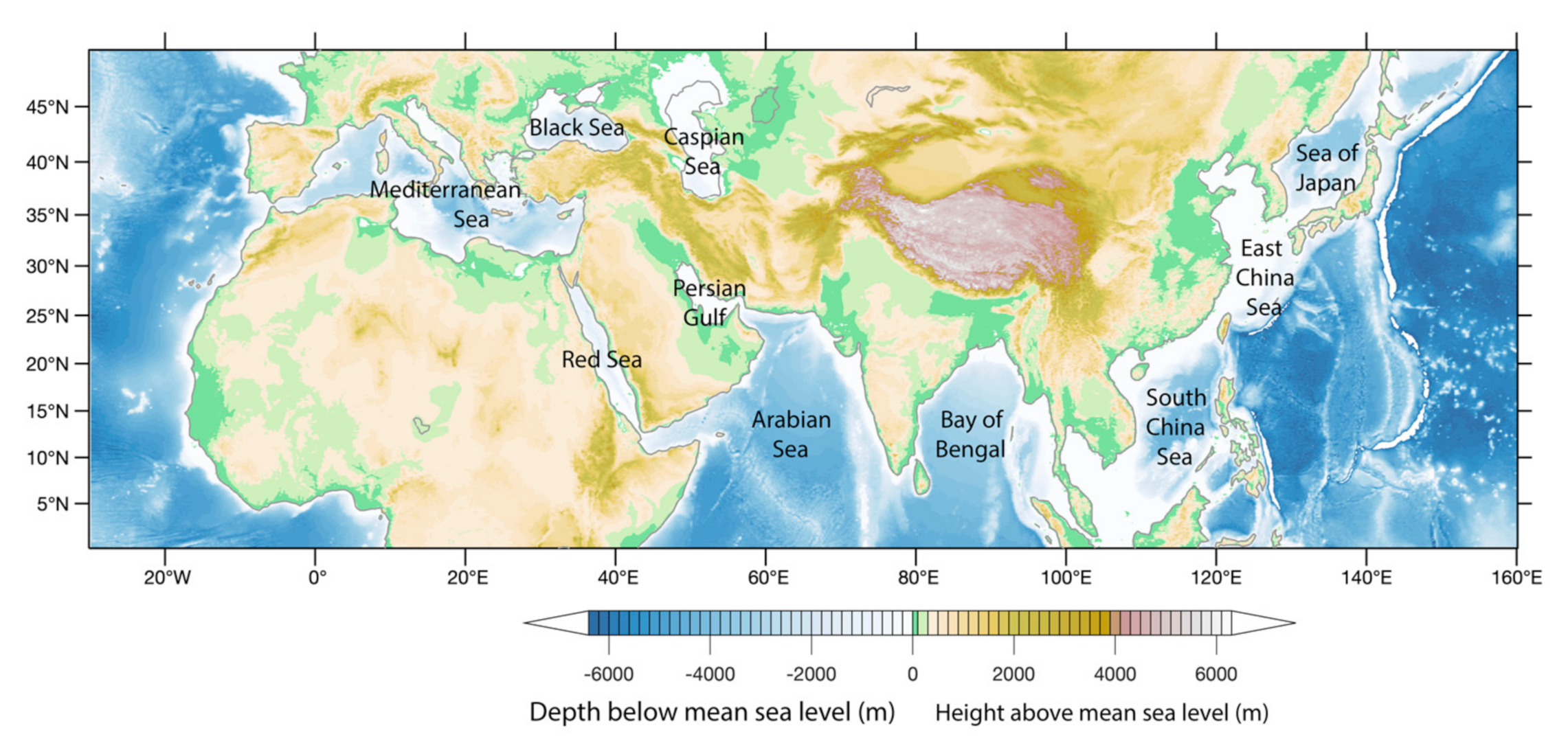
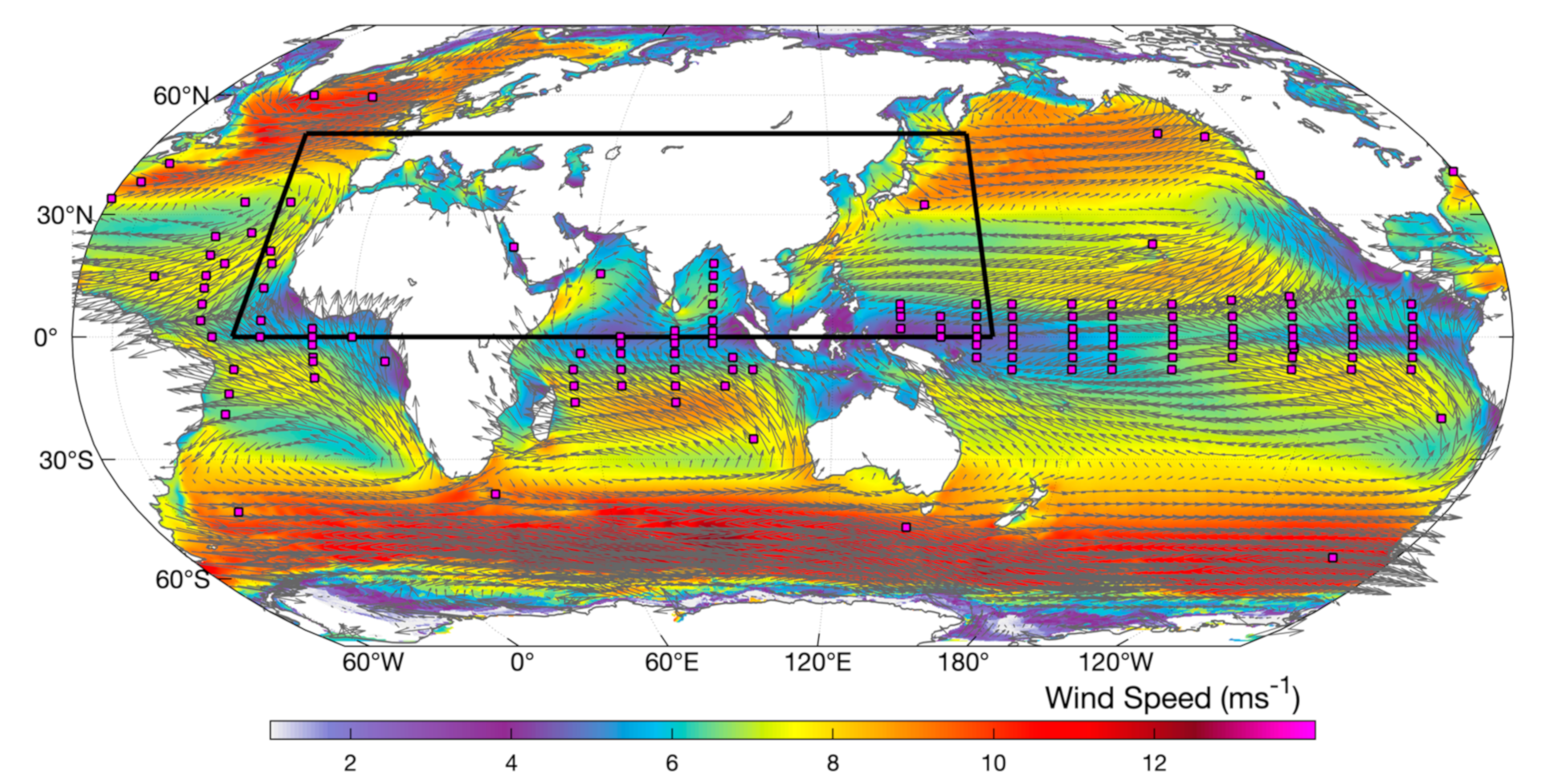
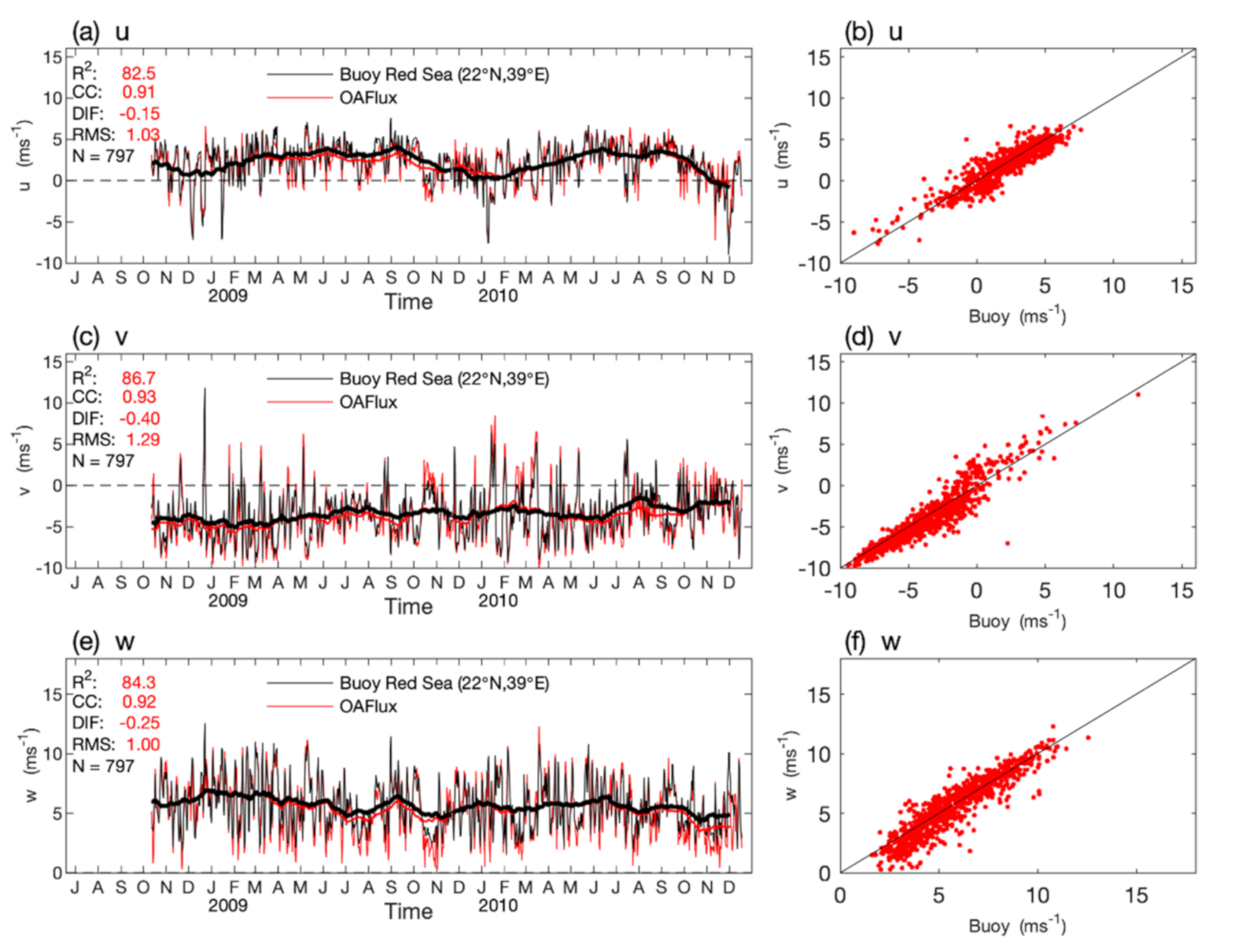
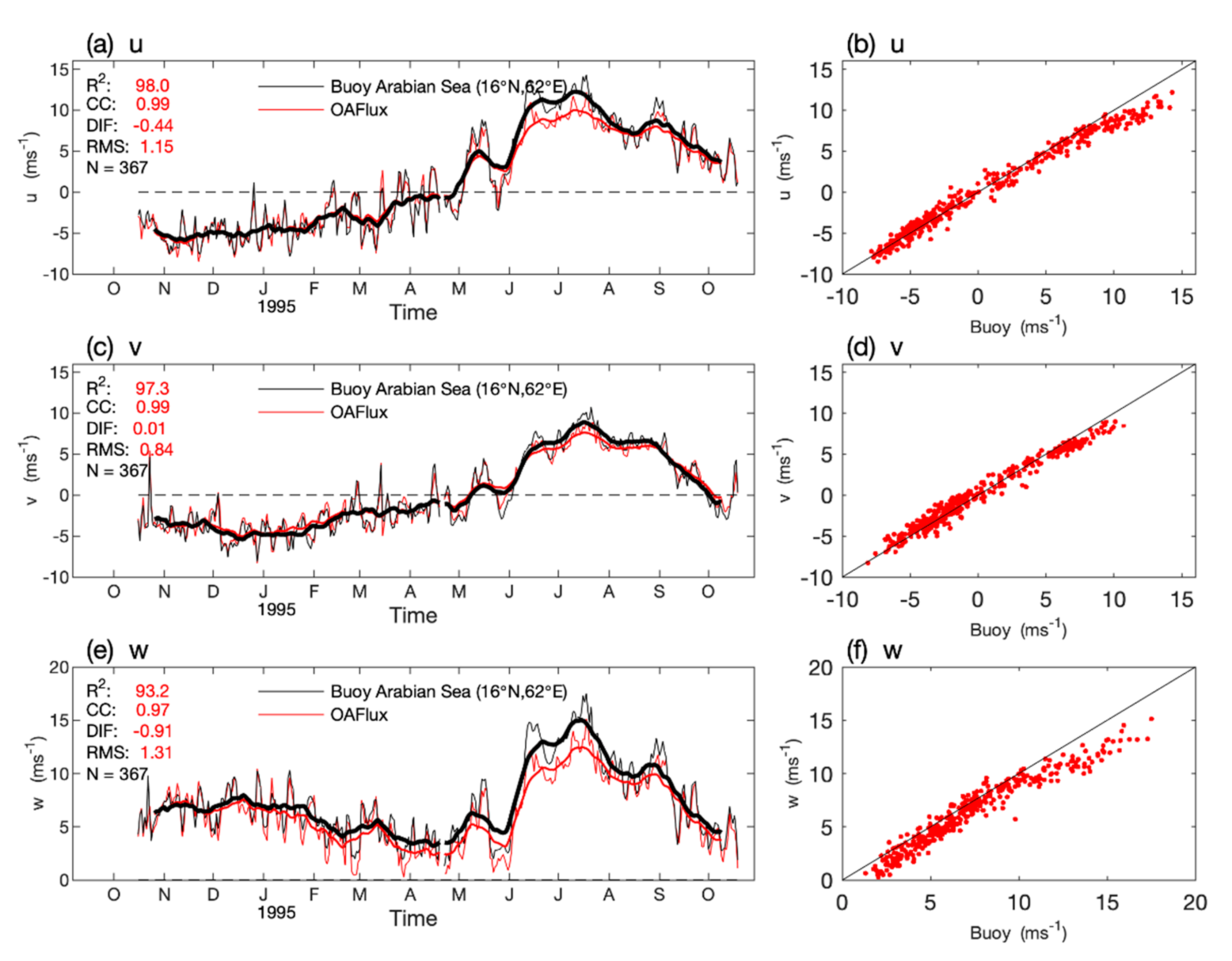
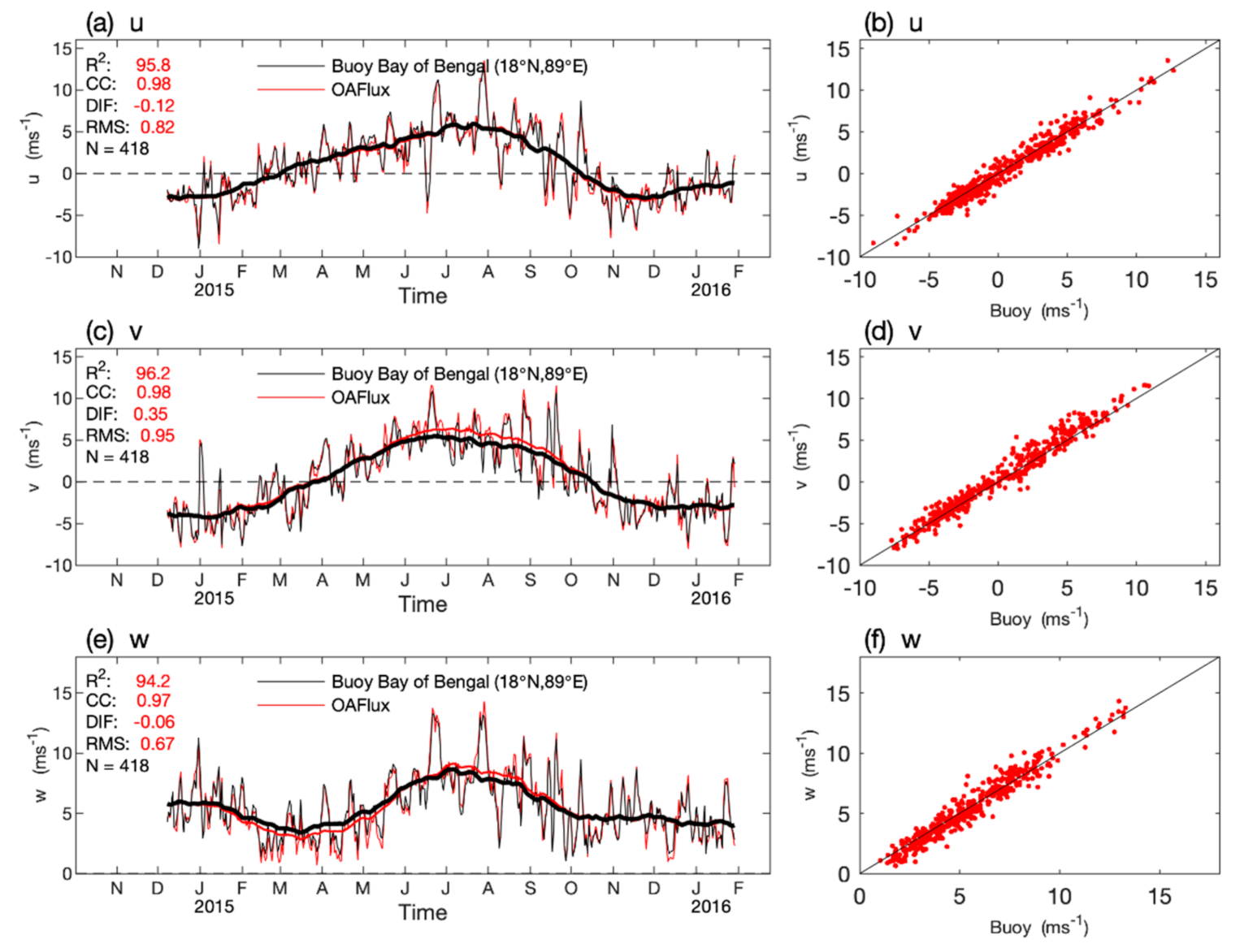


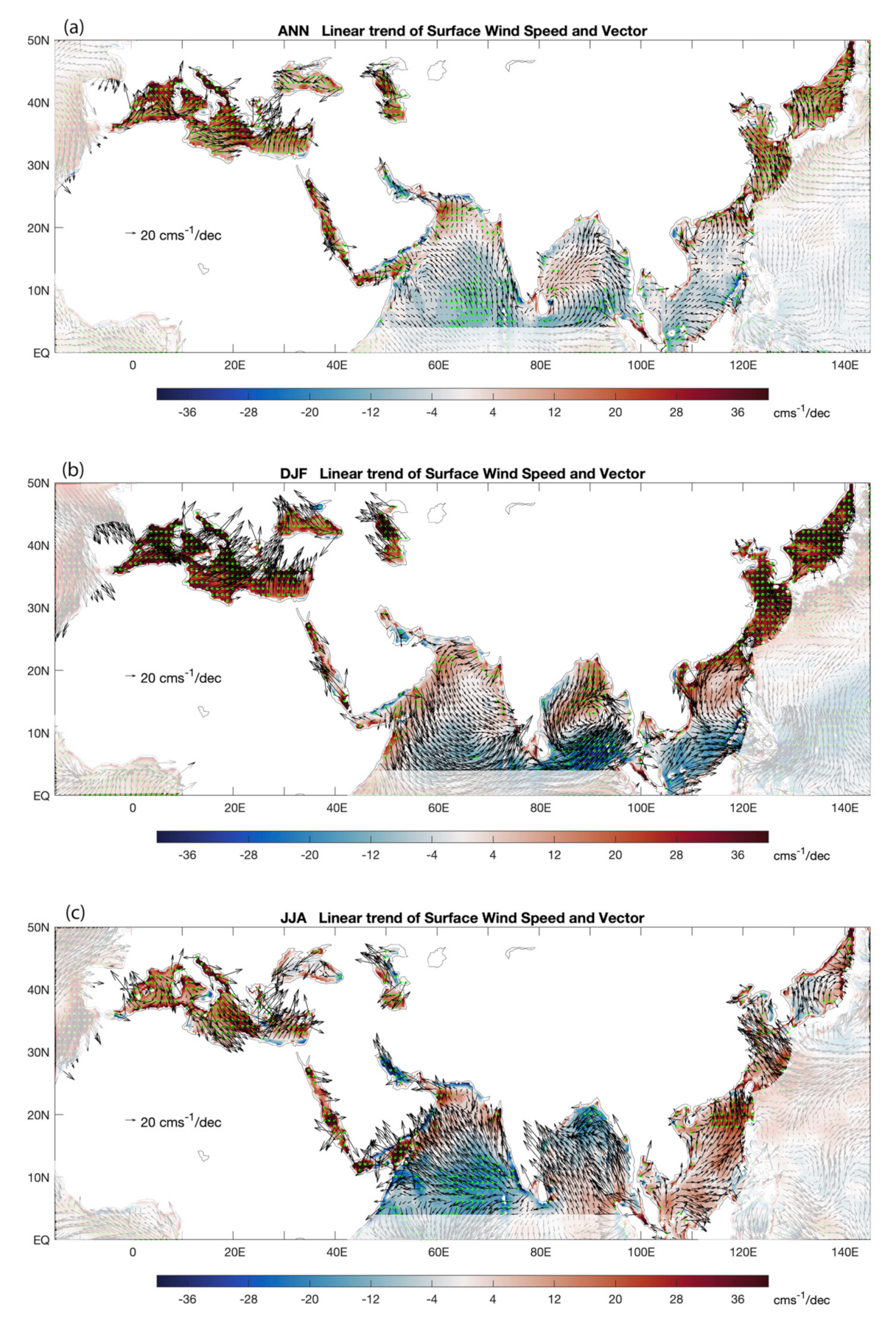
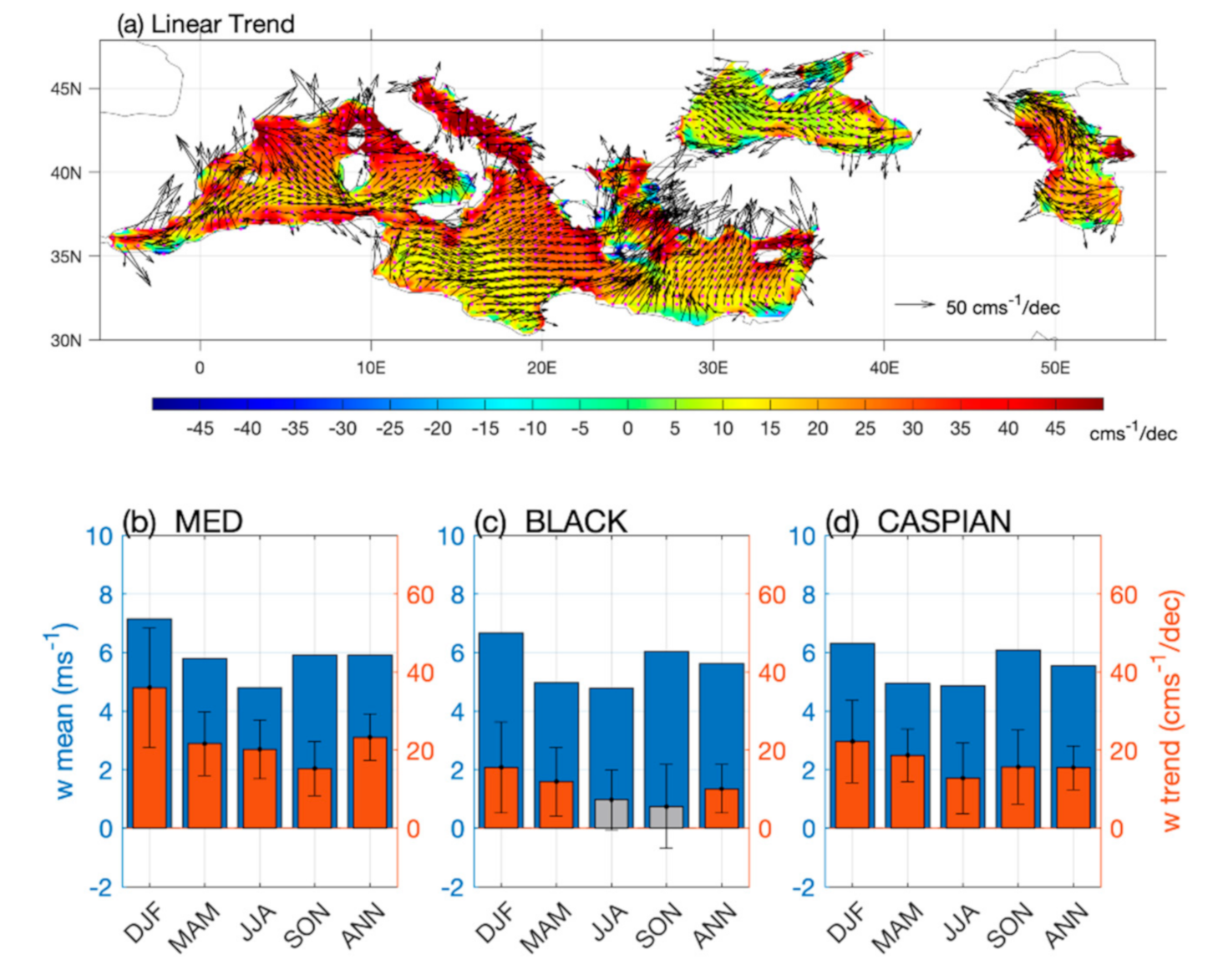




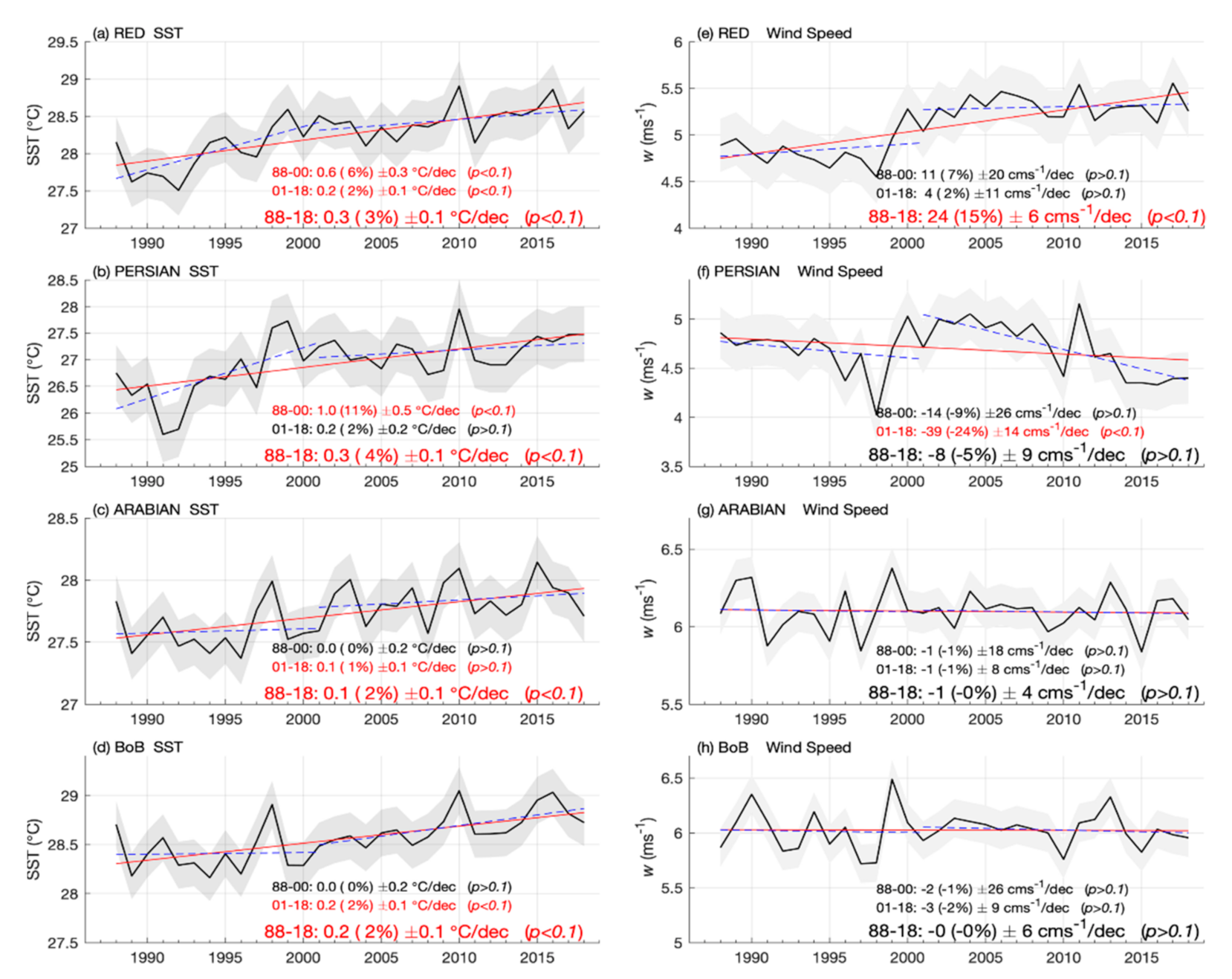
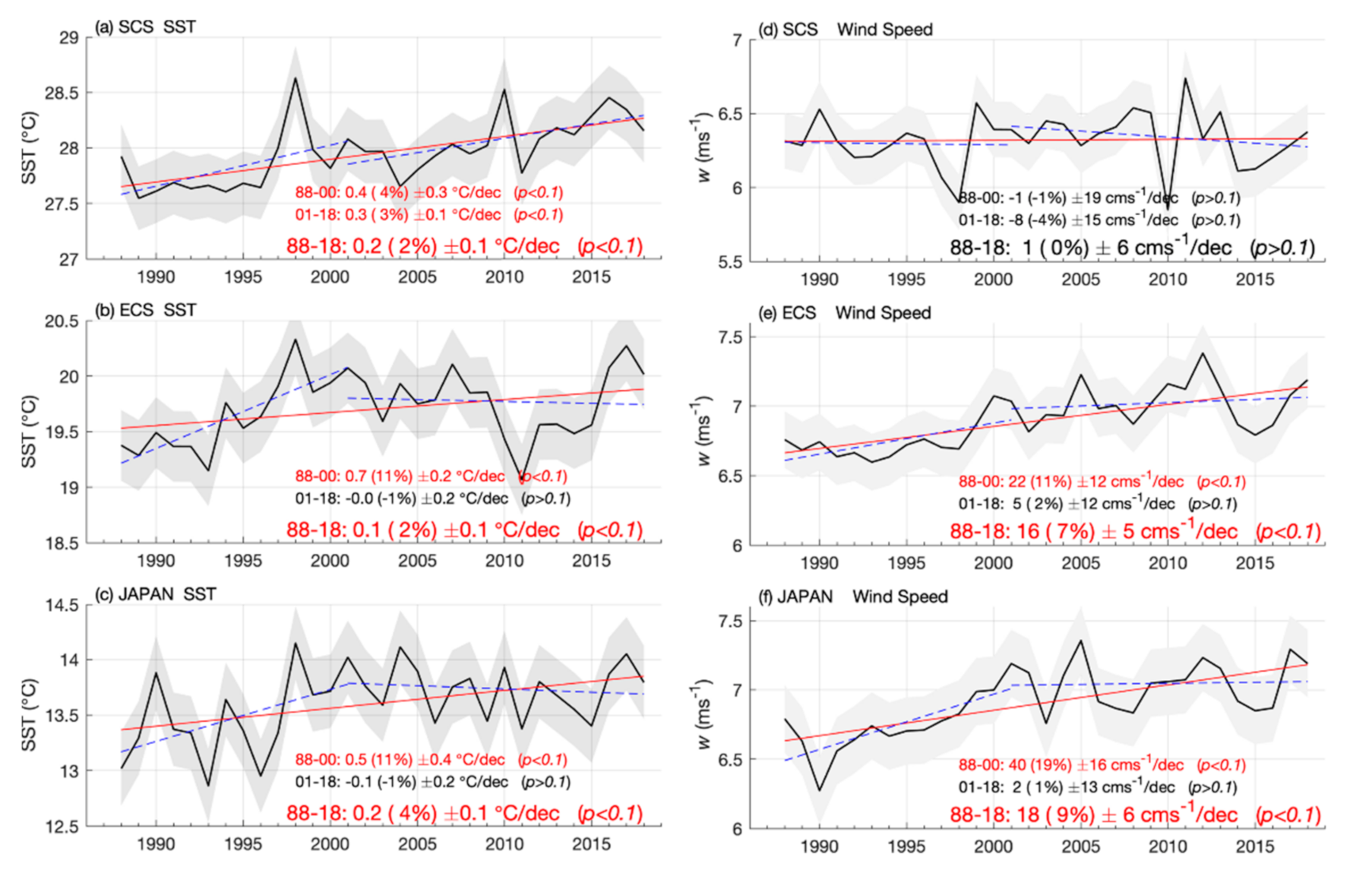
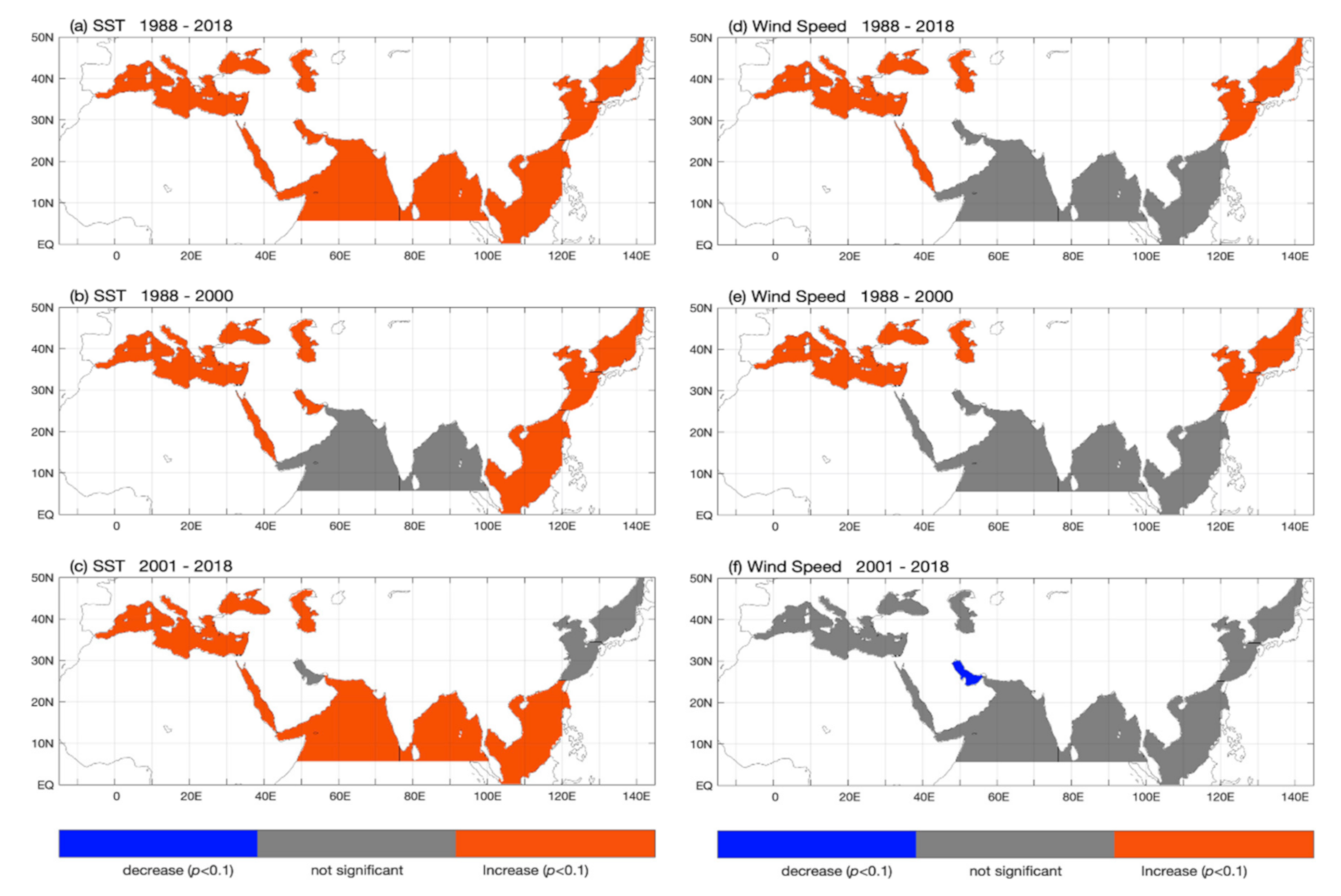
| Instrument | Platform | Duration | Actual Period in Use | Frequency Band (GHz) | Effective Spatial Resolution along (km) × across (km) | Swath Width (km) | Daily Coverage | Reference |
|---|---|---|---|---|---|---|---|---|
| NSCAT | ADEOS-I | 15 September 1996–30 June 1997 | All | 13.995 Ku-band | 25 × 25 | 2 swaths of 600 km | 77% | Freilich and Dunbar [20] |
| QuikSCAT | NASA QuikSCAT | 27 October 1999–21 November 2009 | All | 13.4 Ku-band | 25 × 38 | 1400 | 92% | Stiles & Dunbar [46] |
| ASCAT-A | EUMETSAT MetOp series | 28 March 2007–present | All | 5.255 C-band | 12.5 × 12.5 | 2 swaths of 500 km | 71% | Verhoef and Stoffelen [22] |
| ASCAT-B | 29 October 2012–present | |||||||
| OSCAT | ISRO | 23 September 2009–01 April 2014 | All | 13.5 Ku-band | 12.5 × 12.5 | 1420 | 92% | Kumar et al. [21] |
| SSM/I 08 | DMSP | 9 July 1987–31 December 1991 | All | 19.35, 22.235, 37.0 | 69 × 43 50 × 40 37 × 28 | 1394 | 75% | Wentz [2] |
| SSM/I 10 | DMSP | 8 December 1990–14 November 1997 | All | |||||
| SSM/I 11 | DMSP | 3 December 1991–16 May 2000 | All | |||||
| SSM/I 13 | DMSP | 3 May 1995–18 November 2009 | All | |||||
| SSM/I 14 | DMSP | 8 May 1997–23 August 2008 | 8 May 1997–31 December 2005 | |||||
| SSM/I 15 | DMSP | 18 December 1999–present | 18 December 1999–30 June 2006 | |||||
| SSMIS 16 | DMSP | 26 October 2003–present | 26 October 2003–31 December 2009 | 19.35 22.235 37.0 | 69 × 43 50 × 40 37 × 28 | 1700 | 80% | |
| SSMIS 17 | DMSP | 14 December 2006–present | All | |||||
| AMSR-E | NASA Aqua | 1 June 2002–4 October 2011 | All | 18.7 23.8 36.5 | 27 × 16 32 × 18 14 × 8 | 1450 | 77% | |
| AMSR2 | JAXAGCOM-W1 | 2 July 2012–present | All | 10.7 18.7 23.8 36.5 | 46 × 27 25 × 14 29 × 17 14 × 8 | 1450 | 77% | |
| WindSAT | DoD/Navy Coriolis | 5 February 2003–present | w: all data u,v: 05 February 2003–31 December 2013 | 6.8, 10.7, 18.7, 23.8, 37.0 | 25 × 38 | 1025 | 72% |
| Statistics | Total Number of Collocations | Bias (OA-Buoy) (ms−1) | RMS (ms−1) | CC | R2 (%) | |
|---|---|---|---|---|---|---|
| Wind Component | ||||||
| w | 478,334 | −0.03 | 0.77 | 0.93 | 87.4 | |
| u | 468,346 | −0.17 | 1.26 | 0.95 | 90.1 | |
| v | 468,346 | 0.18 | 1.17 | 0.94 | 88.5 | |
| Buoy | Duration | Wind | Bias (OA−Buoy) (ms−1) | RMS (ms−1) | CC | R2 (%) |
|---|---|---|---|---|---|---|
| Red Sea 22°N, 39°E | 11 October 2008–17 December 2010 N = 797 days | w | −0.25 | 1.00 | 0.92 | 84.6 |
| u | −0.15 | 1.03 | 0.91 | 82.8 | ||
| v | − 0.40 | 1.29 | 0.93 | 86.5 | ||
| Arabian Sea 16°N, 62°E | 15 October 1994–10 October 1995 N = 367 days | w | −0.91 | 1.31 | 0.97 | 94.1 |
| u | −0.44 | 1.15 | 0.99 | 98.1 | ||
| v | 0.01 | 0.84 | 0.99 | 98.4 | ||
| Bay of Bengal 18°N, 89°E | 8 December 2014–30 January 2016 N = 418 days | w | −0.06 | 0.67 | 0.97 | 94.3 |
| u | −0.12 | 0.82 | 0.98 | 96.2 | ||
| v | 0.35 | 0.95 | 0.98 | 96.5 |
| Marginal Sea | Trend 1988–2018 | Trend 1988–2000 | Trend 2001–2018 | ||||
|---|---|---|---|---|---|---|---|
| SST (°C/dec) | Wind Speed (cms−1/dec) | SST (°C/dec) | Wind Speed (cms−1/dec) | SST (°C/dec) | Wind Speed (cms−1/dec) | ||
| MED | 0.4 ± 0.1 | 24 ± 5 | 0.3 ± 0.3 | 36 ± 16 | 0.4 ± 0.1 | 3 ± 8 | |
| BLACK | 0.6 ± 0.1 | 11 ± 6 | 0.7 ± 0.4 | 45 ± 24 | 0.6 ± 0.3 | −4 ± 10 | |
| CASPIAN | 0.4 ± 0.1 | 17 ± 5 | 0.8 ± 0.4 | 31 ± 16 | 0.3 ± 0.2 | 7 ± 9 | |
| RED | 0.3 ± 0.1 | 24 ± 6 | 0.6 ± 0.3 | 11 ± 20 | 0.2 ± 0.1 | 4 ± 11 | |
| PERSIAN | 0.3 ± 0.1 | −8 ± 9 | 1.0 ± 0.5 | −14 ± 26 | 0.2 ± 0.2 | −39 ± 24 | |
| ARABIAN | 0.1 ± 0.1 | −1 ± 4 | 0.0 ± 0.2 | −1 ± 18 | 0.1 ± 0.1 | −1 ± 8 | |
| BoB | 0.2 ± 0.1 | −0 ± 6 | 0.0 ± 0.2 | −2 ± 26 | 0.2 ± 0.1 | −3 ± 9 | |
| SCS | 0.2 ± 0.1 | 1 ± 6 | 0.4 ± 0.3 | −1 ± 19 | 0.3 ± 0.1 | −8 ± 15 | |
| ECS | 0.1 ± 0.1 | 16 ± 5 | 0.7 ± 0.2 | 22 ± 12 | −0.0 ± 0.2 | 5 ± 12 | |
| JAPAN | 0.2 ± 0.1 | 18 ± 6 | 0.5 ± 0.4 | 40 ± 16 | −0.1 ± 0.2 | 2 ± 13 | |
Publisher’s Note: MDPI stays neutral with regard to jurisdictional claims in published maps and institutional affiliations. |
© 2021 by the author. Licensee MDPI, Basel, Switzerland. This article is an open access article distributed under the terms and conditions of the Creative Commons Attribution (CC BY) license (https://creativecommons.org/licenses/by/4.0/).
Share and Cite
Yu, L. Emerging Pattern of Wind Change over the Eurasian Marginal Seas Revealed by Three Decades of Satellite Ocean-Surface Wind Observations. Remote Sens. 2021, 13, 1707. https://doi.org/10.3390/rs13091707
Yu L. Emerging Pattern of Wind Change over the Eurasian Marginal Seas Revealed by Three Decades of Satellite Ocean-Surface Wind Observations. Remote Sensing. 2021; 13(9):1707. https://doi.org/10.3390/rs13091707
Chicago/Turabian StyleYu, Lisan. 2021. "Emerging Pattern of Wind Change over the Eurasian Marginal Seas Revealed by Three Decades of Satellite Ocean-Surface Wind Observations" Remote Sensing 13, no. 9: 1707. https://doi.org/10.3390/rs13091707
APA StyleYu, L. (2021). Emerging Pattern of Wind Change over the Eurasian Marginal Seas Revealed by Three Decades of Satellite Ocean-Surface Wind Observations. Remote Sensing, 13(9), 1707. https://doi.org/10.3390/rs13091707






